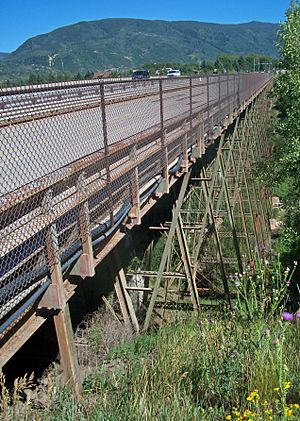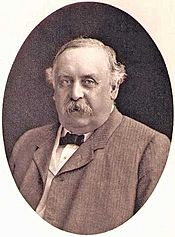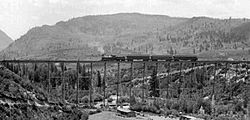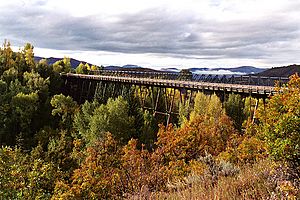Maroon Creek Bridge facts for kids
Quick facts for kids Historic Maroon Creek Bridge |
|
|---|---|

Bridge from west portal, 2010
|
|
| Coordinates | 39°12′4″N 106°50′57″W / 39.20111°N 106.84917°W |
| Carries | Pedestrians |
| Crosses | Maroon Creek |
| Locale | Aspen, CO, USA |
| Characteristics | |
| Design | trestle |
| Material | Concrete, steel, stone |
| Total length | 651 ft (198 m) |
| Width | 40 ft (12 m) |
| Height | 90 ft (27 m) |
| Longest span | 600 ft (180 m) |
| Number of spans | 20 |
| History | |
| Designer | George S. Morison |
| Constructed by | Colorado Midland Railroad |
| Construction begin | 1887 |
| Construction end | 1888 |
| Opened | 1888 |
| Closed | 2008 |
| New Maroon Creek Bridge | |
|---|---|
| Coordinates | 39°12′5″N 106°50′57″W / 39.20139°N 106.84917°W |
| Carries | |
| Crosses | Maroon Creek |
| Locale | Aspen, CO, USA |
| Maintained by | Colorado Department of Transportation |
| ID number | H-09-U |
| Characteristics | |
| Design | Box girder |
| Total length | approx 610 ft (190 m) |
| Width | 73 |
| Height | approx 90 ft (27 m) |
| Longest span | approx 270 ft (82 m) |
| Number of spans | 3 |
| History | |
| Designer | Parsons Transportation Group |
| Engineering design by | McNary Bergeron & Associates |
| Constructed by | BTE Concrete/Atkinson Construction JV |
| Construction begin | 2005 |
| Construction end | 2008 |
| Opened | 2008 |
| Statistics | |
| Daily traffic | 22,300 cars daily |
The Maroon Creek Bridge is actually two bridges located near Aspen, Colorado. The older bridge is a historic steel trestle bridge built in 1888. It was designed by George S. Morison for the Colorado Midland Railroad. This bridge was one of the last large railroad bridges built in Colorado during the 1800s. It is the only one of five steel bridges built by the Midland Railroad that is still standing.
Today, the old bridge is a visible reminder of the railroad's history in Aspen. In 1985, it was added to the National Register of Historic Places. The newer bridge, completed in 2008, carries State Highway 82 traffic. It was designed to look similar to the old bridge. The original bridge is now used by people walking or biking.
Contents
What are the Maroon Creek Bridges like?
Both the old and new Maroon Creek Bridges are found next to each other. They are along Highway 82, about one-half mile (1 km) east of Aspen. This area is close to the traffic circle where Maroon Creek Road begins. The creek flows through a deep gorge below the bridges.
The Historic Bridge: A Steel Trestle
The original bridge is a steel trestle bridge. It has 20 sections supported by nine tall, narrow steel towers called piers. These piers are made of strong steel parts. They are supported by masonry (stone or brickwork) at the ground.
The bridge was built to carry trains. Later, it was changed to carry cars. It is about 651 feet (198 meters) long and 90 feet (27 meters) high. A steel safety net was put in the small space between the two bridges. This helps keep people safe.
The New Bridge: A Modern Design
The new bridge is a box girder design. It is made of concrete and is about 610 feet (186 meters) long. It has a main span of about 270 feet (82 meters). The bridge deck is 73 feet (22 meters) wide.
It is supported by A-shaped concrete piers. These piers are designed to look like the supports on the old bridge. The piers are set deep into the bedrock (solid rock beneath the soil). This makes them very strong.
A Look Back: The Bridges' History
The story of the Maroon Creek Bridge is closely linked to the city of Aspen. It was built during a time when Aspen was a busy silver mining town. The bridge helped connect Aspen to the rest of the world.
Aspen's Early Days and the Railroad Race
Aspen started as a mining camp in the late 1870s. Prospectors came looking for silver. The city grew quickly because of its location and nearby forests. At first, it was hard to get the silver ore out. It had to be taken to Leadville to be processed. The route over the mountains was long and difficult.
In the mid-1880s, a local processing plant opened. This made mining more profitable. Two railroads, the Colorado Midland and the Denver & Rio Grande Western, began building tracks to Aspen. They were racing to be the first to reach the booming town.
Building the Bridge and Early Train Use
The Colorado Midland Railroad hired a famous engineer named George S. Morison. He designed the Maroon Creek Bridge. His design used strong, innovative piers. The Midland crews reached Maroon Creek in December 1887. They had to wait for the steel for the bridge to arrive.
Because of this delay, the Denver & Rio Grande Western Railroad won the race. Their first train arrived in Aspen in October 1887. The Midland's first train crossed the completed Maroon Creek Bridge in February 1888. Even though the Midland lost the race, its bridge was important. It connected Aspen to a main railroad line.
Aspen's silver boom ended in 1893. This was due to an economic downturn. Many mines closed, and the city entered a quiet period. The Colorado Midland Railroad eventually went out of business. The Maroon Creek Bridge was left unused for a time.
From Railroad to Road Bridge
About ten years later, the bridge found a new purpose. As more people started using cars, Colorado began improving its roads. The bridge was widened and paved. In 1929, it reopened for road traffic as part of Highway 82. This helped connect Aspen to the state's growing road network.
The Great Depression slowed down any new growth. The road and railroad were mainly used to transport livestock. However, Aspen's economy eventually bounced back. This was thanks to the development of downhill skiing. After World War II, Aspen became a popular ski resort. The bridge became the main entrance for many visitors.
Growth of Aspen and Traffic Challenges
As Aspen grew, the bridge became a very busy spot. The Aspen Skiing Company developed more ski areas nearby. The Aspen–Pitkin County Airport was built in 1953. All this growth meant more traffic on Highway 82 and over the bridge.
In 1963, the bridge was made wider to handle the increased traffic. In 1969, train service to Aspen ended. The tracks were removed, and the train station was torn down. This left the Maroon Creek Bridge as the only major reminder of Aspen's railroad past.
By the 1980s, the old bridge was showing its age. Traffic continued to increase. The Colorado Department of Transportation (CDOT) started planning for a new bridge. Drivers also had to share the narrow bridge with pedestrians. A temporary pedestrian bridge was built in 1998 to help.
The New Bridge is Built
In the early 2000s, the old bridge was in poor condition. It was temporarily closed to trucks for repairs. In 2004, plans for a new bridge moved forward. Construction began in late 2005. The new bridge was designed to be similar in appearance to the historic one.
The new bridge was built from the top down. This was done to protect the wetlands below. The construction continued through the winter months. The entire new bridge was finished in early 2008. The 120-year-old original bridge had been the oldest one still in use on Colorado's state highways.
The new bridge opened in mid-2008. It cost almost $14 million. The old bridge was kept in place because of its historical importance. It is now used as a pedestrian bridge. In 2010, CDOT won an award for the new bridge's design.
What's Next for the Bridges?
There is a possibility that trains could return to the old bridge. Since 1975, Aspen voters have supported the idea of a light rail system. This system would connect downtown Aspen to the airport. It might even go all the way to Glenwood Springs.
The light rail line would likely use the old bridge. It would also use parts of the old Midland railroad route. These routes already have the right slopes for trains. While funding has been a challenge, the idea of light rail in the valley is still discussed.
Some parts of the old pedestrian bridge, which was removed, are being reused. Some sections were sold. Others were used to build a new pedestrian bridge near Basalt. More sections are in storage and might be used for other projects in the future.




